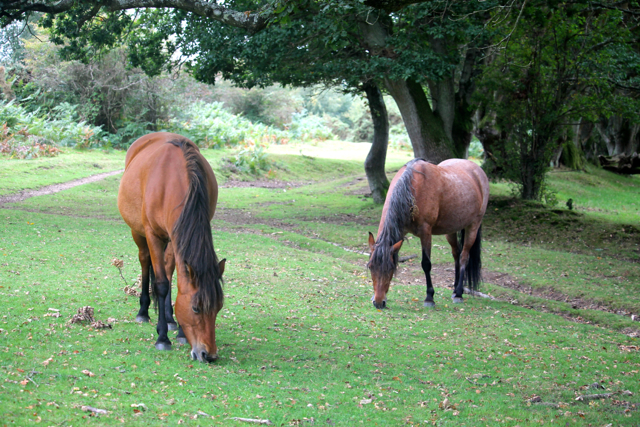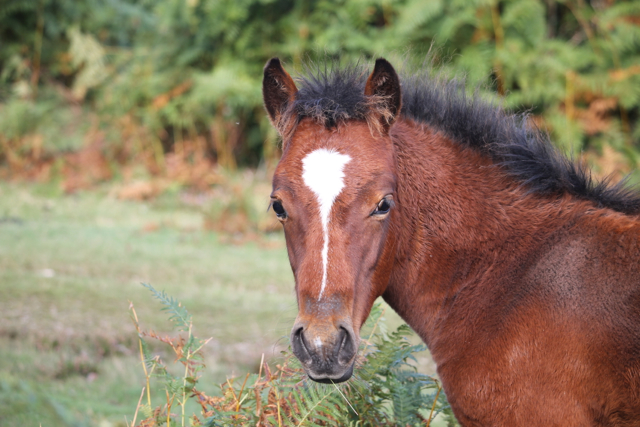
Living ‘wild’ means that New Forest ponies cannot be managed in the same way as domesticated horses and ponies, but they are managed nonetheless.
Being a commoner enables me to practice a method of farming that pre-dates recorded history. The ancient commoner would have orally passed on his or her learning and wisdom to the next generation. This ensured that the chain of folk-knowledge, about managing livestock and the resources of the Forest, would continue through those who followed after. Even today scientific studies and ‘painstaking quantification [regarding the social behaviour and ecology of the Forest ponies and cattle] has ‘only’ served to confirm much that has been common knowledge or opinion among commoners for generations’.[1] The commoners tend to take a pragmatic approach to stock management and will solicit natural forces to help them share the responsibilities for their animal’s health and wellbeing. Living ‘wild’ means that ponies cannot be managed in the same way as domesticated horses and ponies, but they are managed nonetheless. The Agisters, who are employed by the New Forest Verderers to assist in the management of commoners’ stock, patrol the Forest regularly often on horseback making sure that the welfare of the free-roaming ponies, donkeys, cattle and pigs is maintained.
Toilet training for ponies
The ponies, having themselves been descended from semi-feral ancestors, are hardy and well adapted to the environment. They range widely and know where to find food, water, and shelter in their territories. It is even said that they know where on the Forest to find the health-giving herbs required to provide them relief from parasites and to prevent illness. Within their territories the ponies will also ‘manage’ their own grazing by selecting latrine areas, which all animals use for their toilet needs, leaving large areas of grass free of dung. The only exceptions to this are generally foals until they have been ‘toilet trained’ by their mothers and herd-elders. Adopting this method of equine induced land management means that internal parasites can be better avoided because rarely do ponies graze the latrine areas. The free-roaming ponies are not routinely wormed with chemical wormers to kill internal parasites, as is the case with domesticated animals. However, if any of the free-roaming ponies show signs of a ‘worm burden’ due to parasitic infestation they are wormed with the appropriate drug treatment. Generally, it is the young stock that are more prone to certain conditions because they haven’t yet learned how to properly self-medicate on the natural remedies of the Forest. The autumn drifts present an excellent opportunity to round up the ponies and check them for health. Any animals that are thought to be in need of treatment, including worming, but have failed to come in will be caught in a colt-hunt which, although it uses similar techniques to the large-scale drifts, is only used for catching individual animals.
Mucky talk!
Because the free-roaming ponies are not given regular doses of wormer, which contain drugs designed to kill internal parasites, the composition of their droppings is not toxic to the microorganisms, fungi and insects that depend upon the excreted animal waste as a food source. These many species of dung-eaters will themselves become food for the many species of bats, birds, and foxes, for example, which are resident in the New Forest. As a result of their benign composition the droppings decompose a lot faster from the ground than those of animals treated with wormers and, as a result, the latrine areas do not become overly soiled. I’ve noticed that the domesticated ponies on my holding have their toilet areas too and since adopting worm-counts, where samples of dung are sent to be laboratory analysed for the presence of parasite eggs, rather than routine chemical worming, I have not only improved my pasture but, if I can collect it in time, the quality of the manure that then goes onto the garden.
[1] Tubbs, Colin R, The New Forest: History, Ecology & Conservation, Lyndhurst, 2001, p136.
See also:
The Distribution of Excreta on New Forest Grassland Used by Cattle, Ponies and Deer Author(s): P. J. Edwards and S. Hollis Source: Journal of Applied Ecology, Vol. 19, No. 3 (Dec., 1982), pp. 953-964 Published by: British Ecological Society Stable
Treating Cattle with Ivermectin: Effects on the Fauna and Decompsition of Dung Pats Author(s): M. Madsen, B. Overgaard Nielsen, P. Holter, O. C. Pedersen, J. Brochner Jespersen, K. -M. Vagn Jensen, P. Nansen and J. Gronvold. Source: Journal of Applied Ecology, Vol. 27, No. 1 (Apr., 1990), pp. 1-15. Published by: British Ecological Society.



You must be logged in to post a comment.